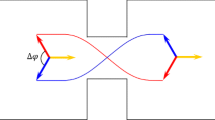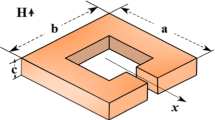Abstract
A single static vortex in a holographic two-band superconductor is constructed. We investigate the effect of the interband coupling to the condensate profile. We estimate the first critical magnetic field, and compute characteristic lengths like penetration and coherence lengths and conclude both bands in our superconductor behave type II.
Similar content being viewed by others
Avoid common mistakes on your manuscript.
1 Introduction
The holography which is best known in the context of AdS/CFT correspondence [1–3] states a gravity theory in a d+1 dimensional AdS space has a dual description of field theory living at its d dimensional boundary. It has been shown as a powerful tool to study various strongly coupled systems. For example, in recent years, it was applied to strongly correlated condensed matter systems like high T c superconductor [4, 5], non-Fermi liquid [6–8], Lifshitz fixed point [9–11] or unitary fermi gas [12], etc. A gravity dual of a single-band superconductor has been constructed by introducing a charged scalar in a AdS black hole background. The charged scalar undergoes an instability below certain critical temperature and form the superconducting condensate. In this note, we generalize the single-band superconductor to a two-band case by introducing two charged scalars with a interband Josephson coupling in a AdS space. We apply a constant external magnetic field and construct a static single vortex solution in this two band superconductor. We also compute the superfluid density, penetration and coherence lengths, and estimate the critical magnetic field.
2 The Model
Consider a two-component Ginzburg-Landau theory in AdS-Schwarzchild black hole as a holographic model of two-band superconductor [13]
where \(V(\psi _{1},\psi _{2})={m_{1}^{2}}|\psi _{1}|^{2}+{m_{2}^{2}}|\psi _{2}|^{2}+\epsilon (\psi _{1}\psi ^{*}_{2}+\psi ^{*}_{1}\psi _{2})+\eta |\psi _{1}|^{2}|\psi _{2}|^{2}\), in which 𝜖 is the interband Josephson coupling, and η is a density-density coupling. To solve this model, we impose the boundary conditions, near the boundary z→0, the asymptotic behaviors of fields are given byFootnote 1
where Δ i satisfies \({\Delta }_{i}({\Delta }_{i}-3)={m^{2}_{i}}\) are related to the dimensions of the dual operator \(\mathcal {O}_{i}\). Here, \(\varphi _{i}^{(1)}\) is interpreted as the source while \(\varphi _{i}^{(2)}\) as the condensate of the dual operator \(\mathcal {O}_{i}\); μ is called as the chemical potential and ρ as the charge density; a ϕ and J ϕ can be interpreted as velocity and current on the dual field theory. On the boundary z→0, we can impose the source-free conditions for charged scalars at a fixed chemical potential μ. Like in [14], we impose that \(a_{\phi }(\rho )=\frac {1}{2}\rho ^{2} B\) where B is the external magnetic field perpendicular to the boundary. We can also define the magnetic field B n = 2n/R 2 where R is the maximum radius of the vortex, in which B n is the magnetic field which penetrates through the vortex. The boundary condition of A ϕ at ρ = R is
We also require the regularity condition, e.g., A t (z = z h )=0 at the horizon and also the conditions at ρ = 0 for n ≠ 0
while for n = 0, ∂ ρ φ ρ = 0 = 0. To avoid the divergence of the energy with the fractional magnetic flux [?], we set n 1 = n 2 = n in our numerical calculations.
3 Numerical Results
In the numerics, we set \({m_{1}^{2}}=-2, {m_{2}^{2}}=-5/4\), q = L = 1, n 1 = n 2 = n, and fix μ = 6.2, η = 0. We will change the Josephson coupling 𝜖 or B to compute various properties of the superconductor vortex. In Fig. 1, we show the condensate profile for small 𝜖 where we find condensate 〈O 2〉 is against 𝜖 which is similar to the condensed matter literature [15], but for 𝜖 is larger, 〈O 2〉 decreases when 𝜖 increases as shown in Fig. 2.
In Fig. 3, we estimate B c1 by comparing the free energy of n = 1 and n = 0 where the regularized free energy is given by
From Fig. 3, one can determine B c1 as the magnetic field where F(n = 1) = F(n = 0) which is about B = 0.09. Therefore, when B<B c1 = 0.09 the superconducting phase without vortex is favored than the superconductor phase with vortex. Conversely, the vortex state is favored when B>B c1 = 0.09.
Inaddition to B c1, the other interesting quantities for the superconductors are the characteristic lengths. We are interested in the penetration length and coherence lengths. The penetration length can be obtained from the superfluid density n s by \(\lambda =\frac {1}{e\sqrt {n_{s}}}\) where e is the electric charge of the superconductor and the superfluid density n s can be defined from the current-current correlator given by [14]
We show the superfluid density in Fig. 4.
For the coherence length, we adopt the approach by fitting the condensate profiles by
and then we can conclude the Ginzburg-Landau parameter κ for both bands in our two-band superconductor are larger than \(1/\sqrt {2}\) and behave type II.
4 Conclusion
In this note, we construct a single vortex solution in a holographic two-band superconductor. We find for small interband Josephson coupling, one condensate is robust against the interband coupling. By comparing the free energy of n = 1 superconducting vortex solution and superconducting solution without vortex, we estimate the first critical magnetic field B c1. We also compute the superfluid density, penetration length, and coherence lengths and conclude both bands in our model behave type II.
Notes
The expansions of φ i are only valid with small 𝜖 and η, i.e., \(\epsilon , \eta \ll {m_{i}^{2}}\), since the terms with 𝜖 and η have the same scaling 1/z 2 as those with \({m_{i}^{2}}\).
References
Maldacena, J.M.: Int. J. Theor. Phys. 38, 1113 (1999)
Maldacena, J.M.: Adv. Theor. Math. Phys. 2, 231 (1998). arXiv:9711200[hep-th]
Witten, E.: Adv. Theor. Math. Phys. 2, 253 (1998). arXiv:9802150[hep-th/]
Hartnoll, S.A., Herzog, C.P., Horowitz, G.T.: Phys. Rev. Lett. 101, 031–601 (2008). arXiv:0803.3295 [hep-th]
Hartnoll, S.A., Herzog, C.P., Horowitz, G.T.: JHEP 0812, 015 (2008). arXiv:0810.1563 [hep-th]
Liu, H., McGreevy, J., Vegh, D.: Phys. Rev. D 83, 065–029 (2011). arXiv:0903.2477 [hep-th]
Wen, W.Y., Wu, S.Y.: Phys. Lett. B 712, 266 (2012). arXiv:1202.6539 [hep-th]
Wen, W.Y., Wu, S.Y.: Int. J. Mod. Phys. Conf. Ser. 21, 143 (2013)
Kachru, S., Liu, X., Mulligan, M.: Phys. Rev. D 78, 106005 (2008). arXiv:0808.1725 [hep-th]
Sun, J.R., Wu, S.Y., Zhang, H.Q.: Phys. Rev. D 87, 086–005 (2013). arXiv:1302.5309 [hep-th]
Sun, J.R., Wu, S.Y., Zhang, H.Q.: Phys. Lett. B 729, 177 (2014). arXiv:1306.1517 [hep-th]
Lin, F.L., Wu, S.Y.: Phys. Lett. B 679, 65 (2009). arXiv:0810.0227 [hep-th]
Wen, W.Y., Wu, M.S., Wu, S.Y.: Phys. Rev. D 89(6), 0660–005 (2014). arXiv:1309.0488 [hep-th]
Montull, M., Pomarol, A., Silva, P.J.: Phys. Rev. Lett. 103, 091–601 (2009). arXiv:0906.2396 [hep-th]
Zhitomirsky, M.E., Dao, V.-H.: Phys. Rev. B. 69, 054–508 (2004)
Acknowledgments
The author would like to thank the hospitality of conference “Superstripe 2015” and responses from the participants in the conference. This work is supported by the Ministry of Science and Technology in Taiwan in grant of MOST 104-2914-I-009-021-A1.
Author information
Authors and Affiliations
Corresponding author
Rights and permissions
About this article
Cite this article
Wu, SY. Vortex in Holographic Two-band Superconductor. J Supercond Nov Magn 29, 593–596 (2016). https://doi.org/10.1007/s10948-015-3307-z
Received:
Accepted:
Published:
Issue Date:
DOI: https://doi.org/10.1007/s10948-015-3307-z








